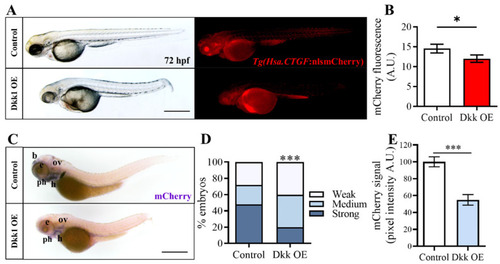
Wnt/β-catenin pathway inhibition through Dkk1 overexpression reduces Tg(Hsa.CTGF:nlsmCherry)ia49 transgene expression. (A) Tg(Hsa.CTGF:nlsmCherry)ia49 fish were outcrossed with the Tg(hsp70:dkk1-GFP)w32 line, and the offspring was heat shocked to induce the overexpression of the Wnt antagonist Dkk1 (Dkk1 OE). Representative images of a double transgenic embryo (Dkk1 OE) at 72 hpf after Dkk1 overexpression compared to WT control siblings (control). (B) mCherry quantification on the entire embryo showed only a modest but significant decrease of fluorescence intensity in Tg(hsp70:dkk1-GFP)w32 larvae after Dkk1 activation; Control (n = 84), Dkk OE (n = 87). (C) In-situ hybridization performed with an antisense probe against mCherry transcript revealed a significant reduction of mCherry mRNA levels after Dkk1 overexpression, compared to the control siblings. The decrease in mCherry mRNA levels is evident in the brain (b), eyes (e), otic vesicle (ov), heart (h), and pharyngeal arches (ph). (D,E) The variation in the in situ hybridization signal intensity was quantified using two independent systems. In (D), the analysis was performed by manually categorizing the embryos of the control and experimental samples (Dkk1 OE) into distinct groups based on the observed signal strength (strong, medium, and weak) at the whole embryo level. In (E), the mCherry signals in each sample (head region) were quantified using the Volocity 6.0 software. Control (n = 321), Dkk OE (n = 288). Scale bar 500 μm. In (B,E), data are presented as mean +/− SEM (Mann−Whitney test); * p < 0.05, *** p < 0.001).
|

